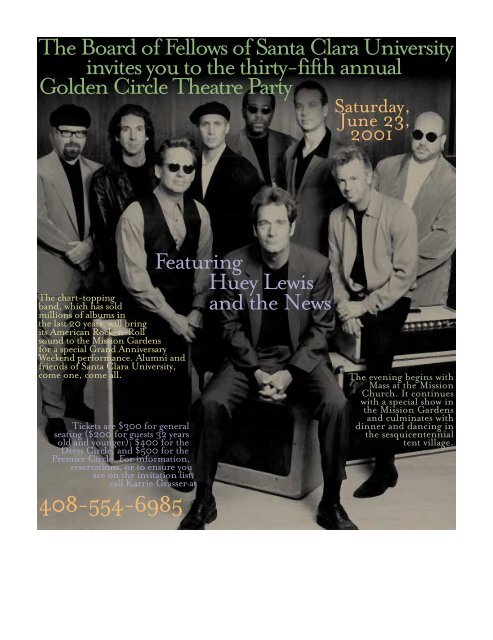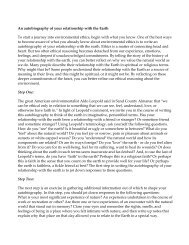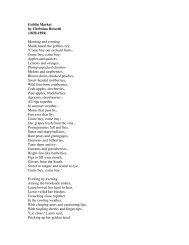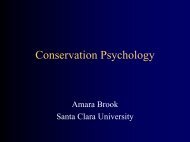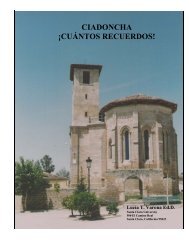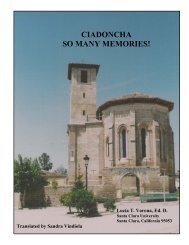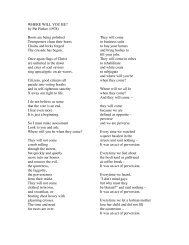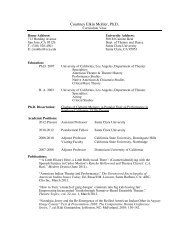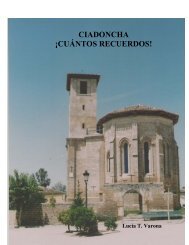*Winter 2001 Magazine CR - Webpages at SCU - Santa Clara ...
*Winter 2001 Magazine CR - Webpages at SCU - Santa Clara ...
*Winter 2001 Magazine CR - Webpages at SCU - Santa Clara ...
You also want an ePaper? Increase the reach of your titles
YUMPU automatically turns print PDFs into web optimized ePapers that Google loves.
The Board of Fellows of <strong>Santa</strong> <strong>Clara</strong> Universityinvites you to the thirty-fifth annualGolden Circle The<strong>at</strong>re PartyS<strong>at</strong>urday,June 23,<strong>2001</strong>The chart-toppingband, which has soldmillions of albums inthe last 20 years, will bringits American Rock-n-Rollsound to the Mission Gardensfor a special Grand AnniversaryWeekend performance. Alumni andfriends of <strong>Santa</strong> <strong>Clara</strong> University,come one, come all.Tickets are $300 for generalse<strong>at</strong>ing ($200 for guests 32 yearsold and younger); $400 for theDress Circle, and $500 for thePremier Circle. For inform<strong>at</strong>ion,reserv<strong>at</strong>ions, or to ensure youare on the invit<strong>at</strong>ion list,call Karrie Grasser <strong>at</strong>408-554-6985Fe<strong>at</strong>uringHuey Lewisand the NewsThe evening begins withMass <strong>at</strong> the MissionChurch. It continueswith a special show inthe Mission Gardensand culmin<strong>at</strong>es withdinner and dancing inthe sesquicentennialtent village.
V O L U M E 4 3 M A G A Z I N E N U M B E R 1SUMMER <strong>2001</strong>A Bronco gold mine:Archives anim<strong>at</strong>e 150years of <strong>Santa</strong> <strong>Clara</strong>University history.Page18AVINGGRACE2The Way We Were 8 Innocence Project 14 Flights of Mercy
ForeWordsCommitted to memorySome of our most endearing—and enduring—memories are from our days on a college campus. From l<strong>at</strong>e night ch<strong>at</strong>s with friendsto early morning classes with inspiring professors, the time spent in a university setting helps shape the person we are to become.The college years are a bridge between youth and adulthood. The trip across this span can be harrowing and exhilar<strong>at</strong>ing <strong>at</strong>the same time. When we asked alumni to share memories of their days here, the responses confirmed th<strong>at</strong> the <strong>Santa</strong> <strong>Clara</strong> experiencewas time well spent and a journey fondly remembered (Pages 2 and 3).On Page 14, we highlight the good deeds of The Flying Doctors volunteers, who don<strong>at</strong>e their time and money to provide freemedical and dental care to needy residents of remote Mexican villages. Bill Stover, an associ<strong>at</strong>e professor <strong>at</strong> <strong>SCU</strong> and a volunteerpilot, takes us along on a recent trip through his photos and journal entries.With the University set to wrap up a year-long celebr<strong>at</strong>ion of its 150th anniversary, associ<strong>at</strong>e editor Elizabeth Gillogly ’93 offersa tour of the University Archives (Page 18).Finally, many thanks to the hundreds of readers who responded to our annual magazine appeal in March. Every dollar of yourtax-deductible gift helps offset production costs.To those of you who have already made a contribution, we thank you. For those who may not have received the appeal letter,you can mail your don<strong>at</strong>ion to <strong>Santa</strong> <strong>Clara</strong> <strong>Magazine</strong>, <strong>Santa</strong> <strong>Clara</strong> University, <strong>Santa</strong> <strong>Clara</strong>, CA 95053–1505.Even if you aren’t able to send a don<strong>at</strong>ion, we hope you’ll keep in touch by sending us your news, story ideas, and feedback.Sincerely,Adam BreenEditorSANTA CLARA MAGAZINE (USPS# 609-240) is published quarterly. February, May, August, andNovember by <strong>Santa</strong> <strong>Clara</strong> University, <strong>Santa</strong> <strong>Clara</strong>, CA. Periodical postage paid <strong>at</strong> <strong>Santa</strong><strong>Clara</strong>, CA, and <strong>at</strong> additional mailing office. Postmaster send address changes to SANTA CLARAMAGAZINE, c/o Donohoe Alumni House, <strong>Santa</strong> <strong>Clara</strong> University, <strong>Santa</strong> <strong>Clara</strong>, CA 95053-1505.The diverse opinions expressed in SANTA CLARA MAGAZINE do not necessarily represent the viewsof the editor or the official policy of <strong>Santa</strong> <strong>Clara</strong> University. Copyright <strong>2001</strong> by <strong>Santa</strong><strong>Clara</strong> University. Reproduction in whole or in part without permission is prohibited.
M A G A Z I N ESUMMER <strong>2001</strong>Published for the alumni and friends of <strong>Santa</strong> <strong>Clara</strong> University150th Anniversary Memories 2In honor of <strong>SCU</strong>’s sesquicentennial year, alumnireflect on their Bronco experiences.“Shen Fu” learned the grace of anger 4By Tennant Wright, S.J. A friend shares his memories ofPhilip Oliger, S.J., who taught him th<strong>at</strong> “passion is thesign th<strong>at</strong> we are alive.”Susan SheaDirector of MarketingAdam BreenEditor, Senior WriterElizabeth Kelley Gillogly ’93Associ<strong>at</strong>e EditorBryan PetersonPeterson & CompanyArt Director, DesignerBecky WadeDesigner, Production AssistantDebra blackVictoria Hendel De La OUniversity Writers, EditorsBarry HoltzclawKelly ShenefielCampus News ContributorsCharles BarryPhotographerAdvisory BoardR. Kelly DetweilerElizabeth Fernandez ’79Miriam SchulmanPaul A. Soukup, S.J.Richard Toomey J.D. ’82An <strong>SCU</strong> professor fliessouth to help others.Winging it 14By Adam Breen. Professor Bill Stover is a volunteerpilot for The Flying Doctors, a humanitarian groupth<strong>at</strong> brings free basic health and dental care tounderprivileged communities in Mexico.Saving Grace 18By Elizabeth Kelley Gillogly ’93. <strong>Santa</strong> <strong>Clara</strong>University’s 150 years come to life in therich collection of letters, photos,documents, and artifacts preserved in theUniversity Archives.Bronco prideflies high in the UniversityArchives.5 Mission M<strong>at</strong>ters24 From Donohoe Alumni House25 Class Notes34 Alumni Calendar35 Coming Attractions36 AfterwordsCover image:Joseph R. Aurreachochea ’19and an unidentified woman.Courtesy of University Archives1
150th AnniversaryHere’s a sampling of the many remembrances<strong>Santa</strong> <strong>Clara</strong> alumni sent us during the past yearin honor of the University’s 150th anniversary.Our regular letters page will resume in theAugust issue. We welcome your correspondence,but ask th<strong>at</strong> you limit your letter to 200 words.Address correspondence to the editor, <strong>Santa</strong><strong>Clara</strong> <strong>Magazine</strong>, <strong>Santa</strong> <strong>Clara</strong> University, <strong>Santa</strong><strong>Clara</strong>, CA 95053-1505; fax, 408-554-5464; or e-mail to scmagazine@scu.edu.Questions? Call Editor Adam Breen <strong>at</strong> 408-551-1840.The Right ChoiceOne of the best decisions I ever made was to<strong>at</strong>tend <strong>SCU</strong>. I began in 1982 with two of my bestfriends who are still my best friends today. Imet my lovely wife the first day of freshmanorient<strong>at</strong>ion and we now have a beautiful familywith three wonderful children. My younger twochildren are fortun<strong>at</strong>e enough to have godparentswho gradu<strong>at</strong>ed from <strong>SCU</strong>. How much differentwould my life have been had I <strong>at</strong>tendedSouthern Cal or Notre Dame? I really don’t wantto know.—JOE ALLEGRETTI ’86The Game of LifeI had the privilege of being part of <strong>Santa</strong> <strong>Clara</strong>football. Coming out of high school I had beenwined and dined by several colleges offering ascholarship, but P<strong>at</strong> Malley and Bill McPhersoncharmed the socks off of my parents, especiallymy mom.P<strong>at</strong> sold the school on the fact th<strong>at</strong> you go toschool to get a degree, and move on. I, ofcourse, had some aspir<strong>at</strong>ions of extending myfootball career beyond college. He told me th<strong>at</strong>this might or might not happen. College is thekey to being a productive part of society wh<strong>at</strong>evercareer you choose, he said. He sold me onwh<strong>at</strong> a first-class college <strong>Santa</strong> <strong>Clara</strong> is and toldme th<strong>at</strong> the friendships th<strong>at</strong> I made there wouldlast for life. You know wh<strong>at</strong>? He was right!—MIKE ANTONELLI ’69Anxiety, Streaking, PrideI have several memories of my years <strong>at</strong> <strong>SCU</strong>th<strong>at</strong> stand out in my mind. The first was theapprehension, anxiety, and anticip<strong>at</strong>ion th<strong>at</strong> Ifelt as I w<strong>at</strong>ched my parents drive away fromorient<strong>at</strong>ion weekend and I knew I was on myown. The second was the streaking craze duringwinter quarter of my freshman year. Andthird was the gre<strong>at</strong>, prideful look in my grandf<strong>at</strong>her’seyes as I walked across the stage <strong>at</strong> thecommencement ceremony. He always hopedhe would live long enough to see me gradu<strong>at</strong>e,and, thank God, he did!—VICTOR P. REPUBLICANO JR. ’77Snow KiddingI will never forget the snowstorm in the winterof 1976. The stuff would find me if I were inHawaii.—BOB STRUNCK ’76CHICAGOA Right of PassageOur daughter, Sara Jane Klinger, is (hopefully)Class of 2003. Our best memory, so far, is afterthe Mass for Welcome Weekend 1999, we heardthis from President Loc<strong>at</strong>elli: “Welcome to the<strong>Santa</strong> <strong>Clara</strong> family.... come back soon...but rightnow, it is time for your sons and daughters tobegin their college experience.” We stood up,took a family snapshot in front of Benson,hugged and kissed Sara, and left. It was truly aright of passage, full of so much emotion. <strong>Santa</strong><strong>Clara</strong> is family.—LINDA AND OLIVER KLINGERHOUSTONAn Ethical StandThanks for teaching ethics before it becamefashionable, keeping the value of honesty alivein business.—KAREN (AID) TOUMI ’72The Best of TimesI enjoyed the best memories and experiencesduring my study <strong>at</strong> <strong>Santa</strong> <strong>Clara</strong> University. Ilearned a lot not only from classes and teachers,but also from other students, friends, <strong>SCU</strong>staff, community, businesses, and the wholearea. Thank you <strong>Santa</strong> <strong>Clara</strong> and the people of<strong>Santa</strong> <strong>Clara</strong>. I will never forget you.—HAMAD A. AL-SHEIKH MBA ’89RIYADH, SAUDI ARABIAStudents, faculty, and staff shared a 150-footlongcake on March 19, which marked the officialtransfer of the Mission <strong>Santa</strong> <strong>Clara</strong> byBishop Joseph Alemany to the Jesuits in 1851.The University don<strong>at</strong>ed a portion of thecake to InnVision, a program th<strong>at</strong> serves thepoor and homeless in the Silicon Valley.Family TiesMy grandf<strong>at</strong>her, Bill Enos, who was a Portugueseimmigrant, contracted with the Universityto dig the basement <strong>at</strong> O’Connor Hall andthe pool <strong>at</strong> Seifert Gymnasium. He also deliveredsand and gravel for those projects. Duringthe 1940s and early 50s (while Fr. Gianera wasCHARLES BARRY2SANTA CLARA MAGAZINE/SUMMER <strong>2001</strong>
150th Anniversarypresident) my grandf<strong>at</strong>her used tohaul the <strong>Santa</strong> <strong>Clara</strong> football team’sequipment to the train st<strong>at</strong>ion in hisdump trucks, for his buddy, “Smitty.”And in l<strong>at</strong>e May 1965, I headed a groupof students who organized our ownVietnam War “teach-in” <strong>at</strong> the old <strong>Santa</strong><strong>Clara</strong> The<strong>at</strong>re on Franklin Street. Seemedpretty radical <strong>at</strong> the time—seems prettytame now.—BOB HOLDERNESS ’65Road WearyAs the class of ’92, we were the lastfreshmen to experience cars drivingthrough campus on The Alameda,although I was not able to experiencethe now-unifying landscape until aftergradu<strong>at</strong>ion. Wh<strong>at</strong> an amazing milestone—andit sure be<strong>at</strong> dodging trafficon the way to class from Campisi!—SCOTT A. HARTUNG ’92Kenna Hall MemoriesWhen I walked through the doors ofKenna Hall in the fall of 1949, myfreshman year <strong>at</strong> <strong>Santa</strong> <strong>Clara</strong>, I feltel<strong>at</strong>ed about finally escaping the restrictions ofparents and high school. I soon realized, however,th<strong>at</strong> the freedom I anticip<strong>at</strong>ed from collegewas not to be. For the class of 1953, the reality offreshman life in an all-male environment meantmand<strong>at</strong>ory study in the room from 7 to 9 in theevening, a brief escape of 45 minutes to dash tothe campus co-op for a Coke and quick game ofpool, then back to the room until lights-out <strong>at</strong> 11.Friday nights, we were allowed out until 10:30,then a big S<strong>at</strong>urday night awaited us until midnight,when the Kenna doors were slammedshut. Since cars were forbidden to freshmen,S<strong>at</strong>urdays often meant visiting F<strong>at</strong>her Schmidt’syouth club across the street, and ogling the localgirls—much to the anger of their male counterparts.As a class, we grumbled, complained, andswore <strong>at</strong> the depriv<strong>at</strong>ions of our freedom, withthe only consol<strong>at</strong>ion th<strong>at</strong> life as sophomores hadto be better.—WILLIAM G. WIEAND ’53Senior PrankDuring the winter of their senior year in 1963, Ernie Giachetti,Ed Dolan, Reno Di Bono, and Rich Morrissey commandeeredLoyola’s official school banner. “Right after we grabbed the banner,we were chased by 10 or 15 Loyola guys who apparently sawthe <strong>SCU</strong> window decal on my car and traced the license number,”Ernie Giachetti, DDS, recalls. A week l<strong>at</strong>er, Giachetti wascalled into the office of Fr. Wilfred H. Crowley, <strong>SCU</strong>’s vice president ofstudent affairs, and told to return the booty in order toavoid ongoing retali<strong>at</strong>ion between the schools. Giachetti says, “Discretionbeing the better part of valor—and wanting to gradu<strong>at</strong>e—wedecided to comply with the request.” But not before they took thisphoto in front of the Mission Church.Those Were The DaysReflecting, as I often do, on those halcyon days<strong>at</strong> <strong>SCU</strong>—1947–51—a flood of memories overwhelmsme. It was a period of acceler<strong>at</strong>edgrowth, a veritable leap from childhood to manhood.Moral and intellectual disciplines weredefined, demanded, and enforced—it was quitesimple, not the least bit vague or complic<strong>at</strong>ed.And wh<strong>at</strong>ever successes came my way, significantcredit must be shared with the social andacademic environment to which I was fortun<strong>at</strong>eenough to be exposed throughout those fourhappy years.—LAWRENCE P. JOHNSTON ’51Like F<strong>at</strong>her, Like SonMy memory is having my son <strong>at</strong>tend my gradu<strong>at</strong>ionin 1959 and then me <strong>at</strong>tending his in 1980.—RICHARD R. CALLAHAN ’59Blind LuckI was having lunch in the Benson cafeteriawhen I noticed a young lady enter.She appeared to be in a rush to receiveher lunch and leave. She managed toget in and out quickly and before I couldfinish swallowing my food, she wasgone. When a mutual friend asked if Iwould consider a blind d<strong>at</strong>e for theSenior Ball, I knew th<strong>at</strong> my prayers hadbeen answered. Ten years after gradu<strong>at</strong>ing,th<strong>at</strong> blind d<strong>at</strong>e who was also theyoung lady I had spied in Bensonbecame my wife. Her name is MarthaTeresa Sanchez-Cortez ’83, and I loveher dearly.—MANUEL CORTEZ ’83Goofs and HoopsI remember listening to Fr. O’Sullivan’sjokes in metaphysics class (and) thebasketball team’s upset of USF <strong>at</strong> theSan Jose Civic Auditorium in 1956–57.—RICHARD B. CLARK ’58Haze-y MemoriesI remember playing in the “powderpuff” championshipgame with my team, “Purple Haze,” underthe lights <strong>at</strong> Buck Shaw Stadium. Even though welost, it was quite an experience.—CATHLEEN N. COBB ’74Fired UpI remember w<strong>at</strong>ching the UCLA/<strong>SCU</strong> basketballgame in Swig during my freshman year. Needlessto say, the Broncos came through. But the bestpart was the school spirit th<strong>at</strong> erupted from campus:we w<strong>at</strong>ched from the ninth floor as hundredsof students poured onto Market Street, screamingand dancing around bonfires until the firedepartment arrived. It was just awesome! A truetestimony of school spirit.—AIMEE CABRERA ’99SANTA CLARA MAGAZINE/SUMMER <strong>2001</strong> 3
150th Anniversary‘Shen Fu’ learned the grace of angerThe following essay recalls the impact Fr. PhilOliger, S.J., had on one of his colleagues <strong>at</strong><strong>SCU</strong>. Fr. Oliger, who died in 1986 <strong>at</strong> age 81,came to <strong>Santa</strong> <strong>Clara</strong> as campus ministerin 1963.Ionce thre<strong>at</strong>ened to throw him outof a rowbo<strong>at</strong>. No one could irrit<strong>at</strong>eme with his calm like old Phil.Though Fr. Phil Oliger, S.J., died 13years ago, he walks with me still. Andwhen I am angry, I remember hiswise words: “Passion is the sign th<strong>at</strong>we are alive.”Like the Chinese, whom headmired, Phil gave nicknames, a suresign of his affection, though often amixed blessing for the personnamed, like his sister, Jo, also knownas “Knucklehead.” I called him“Shen Fu,” the revered title for apriest in old China.I am a fisherman, not adept, but Iknow an expert when I see one. Philwas the finest dry fly fisherman I haveever met. He could wade into a ginclearstream, flo<strong>at</strong>ing the fly n<strong>at</strong>urallydown riffles, around boulders, settlingit on a glass-slick pool. Hecould drop those tiny-fe<strong>at</strong>heredhooks with the lightness of the insectsthey imit<strong>at</strong>ed.I learned much from Phil. Aboutfly fishing, of course, but also aboutthe grace of anger. Once when wewere fishing <strong>at</strong> dusk on a High Sierralake, I was not casting well. Phil said,“Keep your elbow close to yourside”—a key rule for a good cast. Ikept forgetting and he kept repe<strong>at</strong>ing,“Keep your elbow in.” Finally, Iexploded: “If you say th<strong>at</strong> once more,I’ll throw you in the lake.” Phil saidnothing. L<strong>at</strong>er th<strong>at</strong> night over dinner,we talked about the importance of4passion, specifically anger. He said,“It’s good to have someone rouse you. . . so you want to sock him in thejaw.” Or throw him in the lake, Ithought to myself. But Phil welcomedbursts of anger as a sign of humanity,a promise of grace. He believedth<strong>at</strong> anger pushes us to wh<strong>at</strong> he calledthe “committed life” r<strong>at</strong>her than tothe ennui of the “habitual life.” Th<strong>at</strong>evening on the lake he pushed me,as I had w<strong>at</strong>ched him push others inhis funny way.Perhaps Phil learned the grace ofanger during his six and a half yearsin Japanese and Chinese prisons, <strong>at</strong>ime he said he looked back on asPhil welcomed bursts of anger as asign of humanity, a promise of grace.“one of the most fruitful of my life.”Under house arrest for four years(1941-45), Phil and a number ofother Jesuit seminarians and priestswere under the charge of the C<strong>at</strong>holicBishop of Shanghai. There hecontinued his theological studies,though he struggled with the confinement,roll calls <strong>at</strong> odd moments,constant surveillance, and the food.The daily menu was eight-year-oldrice shipped from Saigon as pigfeed. “In time,” he told me with asmile, “the two-inch weevils in therice seemed a tasty meal.” Heslipped from 165 to 120 pounds. OnJune 2, 1944, Bishop Philipe Coteordained him in the prison compound.Phil told me wh<strong>at</strong> prison taughthim:“The illusion is th<strong>at</strong> we are everSANTA CLARA MAGAZINE/SUMMER <strong>2001</strong>Philip Oliger, S.J. (1904-1986)going to have a perfect human life.We are not. Suffering is a necessaryingredient in life, and the earlierwe learn to live with it and drawbenefit from it, the more productiveour life is going to be.”Part of his benefit would come in1949. On his return to China, theCommunists interned him for twoand a half years. Phil rarely mentionedhis time in the Nankinginternment. Under such punishmentto mind and spirit some priestsbecame bitter and fostered a h<strong>at</strong>redof the Communists. Not Shen Fu.Though he suffered, he learned.Shen Fu met Christ in the torturedspirits and sick minds of theprison. He received a kind of trainingth<strong>at</strong> sustained him through theyears as priest, teacher, counselor,and rare friend. He guided many ofus <strong>at</strong> <strong>Santa</strong> <strong>Clara</strong>, as he oncepreached, “to allow grace to bring thehuman mind to goodness.”Tennant Wright, S.J., has taught <strong>at</strong> <strong>SCU</strong> since1956.COURTESY OF UNIVERSITY ARCHIVES
MissionM<strong>at</strong>tersT$20 million gift for new learning centerhe largest single gift in theUniversity’s history will fundendowed scholarships and helptransform the campus library into <strong>at</strong>echnology-infused learning center.Lorry Lokey, founder and presidentof San Francisco-based“Business Wire,” in April pledged$20 million to <strong>SCU</strong>. Lokey, a memberof the Board of Trustees, said hemade his gift in recognition of thevalue of educ<strong>at</strong>ion.“The more <strong>Santa</strong> <strong>Clara</strong>s there are,the better our world is bound tobecome,” said the Stanford gradu<strong>at</strong>e.Lokey’s gift provides $15 millionto cre<strong>at</strong>e a campus learning center,and $5 million for scholarships.<strong>SCU</strong> President Paul Loc<strong>at</strong>elli,S.J., said the new center will combinethe physical resources and professionalsupport of a traditional universitylibrary with wide access to newtechnologies.“We aim to cre<strong>at</strong>e a world-classresource where our faculty and studentscan g<strong>at</strong>her inform<strong>at</strong>ion fromaround the world,” Loc<strong>at</strong>elli said.“Lorry Lokey’s lead gift moves us faralong th<strong>at</strong> p<strong>at</strong>h.”Lokey founded Business Wire, anindependent commercial news service,in 1961.His gift to <strong>SCU</strong> is the largest pledgeor gift by a non-alumnus. The LeaveyFound<strong>at</strong>ion, cre<strong>at</strong>ed by the l<strong>at</strong>e ThomasE. Leavey ’22, has given $30 millionto <strong>SCU</strong> since 1989, including $15million to rebuild the Leavey Center.The University has also received $16.9million since 1995 from the Arlineand Thomas J. Bannan Found<strong>at</strong>ion.Thomas Bannan was a 1923 <strong>SCU</strong>gradu<strong>at</strong>e.A quarter-century for Mayer The<strong>at</strong>re<strong>Santa</strong> <strong>Clara</strong> University commemor<strong>at</strong>ed the 25th anniversary of the Louis B. Mayer The<strong>at</strong>re andthe 35th anniversary of the University’s the<strong>at</strong>re arts major with an “Alumni Performance Fest”Jan. 13.The 575-se<strong>at</strong> Mayer The<strong>at</strong>re was dedic<strong>at</strong>ed in 1975 after receiving additional financial supportfrom San Francisco developer Benjamin Swig and the University’s Board of Fellows, which contributedproceeds from its annual Golden Circle The<strong>at</strong>re Party to the building fund.The Mayer The<strong>at</strong>re and Fess Parker Studio, a 130-se<strong>at</strong> black-box the<strong>at</strong>er, replaced the socalledLifebo<strong>at</strong>, temporary quarters for campus dram<strong>at</strong>ics since the demolition of the historicShip in 1962.Evening activities included a performance fe<strong>at</strong>uring <strong>SCU</strong> the<strong>at</strong>er and dance alumni, includingKurtwood Smith, one of the stars of the FOX television program, “Th<strong>at</strong> ’70s Show.” Smith was anartist in residence <strong>at</strong> <strong>SCU</strong> (1965–67) and appeared <strong>at</strong> the University as a guest artist in subsequentyears. He and his daughter, Laurel Smith ’94, performed a scene from “The Dining Room,”by A.R. Gurney.Suzanne Mayer, a member of the University’s Board of Regents and the daughter of Louis Mayer,the l<strong>at</strong>e motion picture producer who headed Metro-Goldwyn-Mayer from 1924–51, <strong>at</strong>tended theevent. The Mayer Found<strong>at</strong>ion contributed funds toward the the<strong>at</strong>er’s completion.The fund-raising event was sponsored by the Department of The<strong>at</strong>re and Dance and the Centerof Performing Arts (CPA), which hosts the<strong>at</strong>er productions, music performances, and dance concertsthroughout the year.For the CPA’s program schedule and inform<strong>at</strong>ion, visit www.scu.edu/cpa/.Christy L. Blyther '96 (left) cre<strong>at</strong>ed and performeda dance called "Mauf Chai" ("I Want Mercy") <strong>at</strong> theAlumni Performance Fest <strong>at</strong> the Mayer The<strong>at</strong>re.CHARLES BARRYSANTA CLARA MAGAZINE/SUMMER <strong>2001</strong> 5
MissionM<strong>at</strong>tersIBudget funds technology and salariesn February, the Board of Trusteesapproved a $206 million oper<strong>at</strong>ingbudget for the <strong>2001</strong>–02 fiscalyear, including $5.2 million forincreases in salaries for the approxim<strong>at</strong>ely1,450 faculty and staff, plus$3.4 million for technology improvements<strong>at</strong> the University.The budget, which takes effectJuly 1, is approxim<strong>at</strong>ely $11.5 millionlarger than this year’s.“We are committed to deliveringthe highest quality learning experience<strong>at</strong> a good value,” said <strong>SCU</strong>President Paul Loc<strong>at</strong>elli, S.J. “Whileour current programs are wellestablished, we cannot remain st<strong>at</strong>ionarywhile the environment changesaround us.”In response to soaring housingcosts in Silicon Valley, the Universityearlier this year announced a $10million, five-year initi<strong>at</strong>ive to providehousing assistance to recruit andretain faculty.Loc<strong>at</strong>elli said the University willcontinue to hold its undergradu<strong>at</strong>eenrollment targets to current levelsof slightly more than 1,000 freshmenper year, while seeking to increasegradu<strong>at</strong>e school enrollments.The budget includes nearly $42million in institutional, federal, andst<strong>at</strong>e funding for financial aid tostudents. Approxim<strong>at</strong>ely two-thirdsof <strong>SCU</strong> undergradu<strong>at</strong>es receive someform of financial assistance, inscholarships, grants, or loans fromthese sources.Tuition continues to be the largestsource of income for the University,comprising approxim<strong>at</strong>ely 70 percentof revenue. In <strong>2001</strong>–02, theannual tuition and mand<strong>at</strong>ory feesfor incoming freshmen and transferstuition and fees for the <strong>2001</strong>-02 academic yearUndergradu<strong>at</strong>eFULL-TIME STUDENTSAnnualEnrolled prior to fall 1999 $21,522Enrolled after fall 1999 $22,110Will enroll in <strong>2001</strong>–02 $22,572ROOM AND BOARDDouble room $ 5,301Single room $ 6,822Designed single room $ 6,387Triple room $ 4,581Sobr<strong>at</strong>o Complex $ 6,375Meal plan $ 3,135will be $22,572. Tuition for current<strong>SCU</strong> undergradu<strong>at</strong>es will be slightlyless: $21,522 for students whoentered <strong>SCU</strong> prior to 1999, andGradu<strong>at</strong>e Per Unit AnnualSCHOOL OF LAWEndowment to fund scholarships andscientific researchFirst year full-time students $25,560First year part-time students $17,892Upper division students $ 852LLM degree $1,000SCHOOL OF BUSINESS $ 571SCHOOL OF ENGINEERING $ 546COUNSELING PSYCHOLOGY& EDUCATION $ 368PASTORAL MINISTRIES $ 320$22,110 for students who entered<strong>SCU</strong> in 1999 or l<strong>at</strong>er.Basic room and board will be$8,436.Anew endowment will support undergradu<strong>at</strong>e scholarships and scientific research for studentspursuing careers in biology, chemistry, the pharmaceutical industry, or medicine.The ALZA Corpor<strong>at</strong>ion announced in March th<strong>at</strong> it would don<strong>at</strong>e $500,000 over a five-year period tofund the ALZA Corpor<strong>at</strong>ion Science Scholars Endowment <strong>at</strong> <strong>SCU</strong>.Peter Facione, dean of the College of Arts and Sciences, praised the partnership, saying it will“enrich the undergradu<strong>at</strong>e experience of our students and enhance the quality and number of wellpreparedgradu<strong>at</strong>es with science backgrounds to enter the Silicon Valley workforce.”Ernest Mario, ALZA’s chairman and chief executive officer, said the company has benefited from<strong>SCU</strong>’s educ<strong>at</strong>ional programs because the University “has provided a talented pool of new ALZA employeeswho over the years have proven to be excellent contributors to our success. We are delightedto provide this funded endowment to help assure a continuum of gradu<strong>at</strong>es who are competent, motiv<strong>at</strong>ed,and interested in health care.”ALZA Corpor<strong>at</strong>ion, headquartered in Mountain View, is a research-based pharmaceutical companycurrently focused on urology, oncology, and central nervous system products.6SANTA CLARA MAGAZINE/SPRING <strong>2001</strong>
MissionM<strong>at</strong>tersUniversity to endsupport of fr<strong>at</strong>ernitiesand sororitiesAfter a five-month review, theUniversity announced th<strong>at</strong> itwould phase out fr<strong>at</strong>ernities andsororities on campus, ending supportfor them altogether by 2003. Italso pledged expanded social andrecre<strong>at</strong>ional facilities for all students.The decision, announced inMarch by President Paul Loc<strong>at</strong>elli,S.J., followed the study of the Greeksystem by a committee of faculty,staff, and students.The committee recommendedkeeping the system with tighter controlsand increased staff resources,while expanding social and recre<strong>at</strong>ionalprograms for the University’s7,350 students.Loc<strong>at</strong>elli chose to embrace thecommittee’s recommend<strong>at</strong>ion toinvolve students in the cre<strong>at</strong>ion ofgre<strong>at</strong>ly enhanced on-campus socialprograms, and to establish longerhours for food service and recre<strong>at</strong>ionalfacilities.His decision to elimin<strong>at</strong>e theGreek system on campus allows the239 sophomores and juniors whoare members of four fr<strong>at</strong>ernitiesand four sororities to retain theiraffili<strong>at</strong>ions, but makes permanenta suspension instituted last fall of“rushing”—recruiting—of newfr<strong>at</strong>ernity and sorority members <strong>at</strong>the University.In a letter to parents, Loc<strong>at</strong>ellisaid, “I understood when I madethis decision th<strong>at</strong> it was not goingto be a comfortable one, especiallyfor those students directly affected,and th<strong>at</strong> some students, parents,alumni, and friends would notshare my perspective ...Wh<strong>at</strong> struckme, however, as I reviewed theoptions with many informed people,was the reiter<strong>at</strong>ed concern for awider, more welcoming, and livelierset of social opportunities th<strong>at</strong>would benefit all students.”David Forsythe, vice president ofthe IGC, told the San Jose Mercury Newsth<strong>at</strong> “Greek organiz<strong>at</strong>ions havecaused public rel<strong>at</strong>ions problems foruniversities, and I think th<strong>at</strong>’s thebasis behind this decision.”Loc<strong>at</strong>elli said it was “a tough decision,in large measure because thevast majority of our fr<strong>at</strong>ernity andsorority members are terrific individuals—realcampus leaders.”“But I had to think,” he said,“about the longer-term issue: puttingour efforts and resources behinda determined effort to add to thesocial opportunities for the gre<strong>at</strong>estnumber of <strong>Santa</strong> <strong>Clara</strong> students.”The University’s first fr<strong>at</strong>ernitywas formed in 1935; its first sororityin 1946. Membership in <strong>SCU</strong> Greekorganiz<strong>at</strong>ions peaked <strong>at</strong> nearly 19percent in 1993, and is currently <strong>at</strong>388 (240 women and 148 men),which is less than 10 percent ofundergradu<strong>at</strong>es.The <strong>SCU</strong> decision mirrors n<strong>at</strong>ionaltrends. Fr<strong>at</strong>ernity and sororitymembership n<strong>at</strong>ionwide declinedabout 30 percent in the last decade,according to The Chronicle of HigherEduc<strong>at</strong>ion.The full text of the University committee report,and a copy of Loc<strong>at</strong>elli’s letter announcing thedecision, can be found <strong>at</strong> www.scu.edu/provost/docs/greek-review.Eastside Project renamed to honor ArrupeCOURTESY OF WWW.JESUIT.ORGPedro Arrupe, S.J. (1907-1991)The Eastside Project, which provides opportunities forstudents and faculty to work to understand the livesof the marginalized and the poor, changed its name tohonor the former Superior General of the Society of Jesus.The program was renamed The Pedro Arrupe, S.J.Center for Community-Based Learning on Feb. 5, whichmarked the 10th anniversary of the de<strong>at</strong>h of Arrupe,head of the Jesuits from 1965 to 1983.“In renaming the Eastside Project, <strong>Santa</strong> <strong>Clara</strong>University honors the memory of this remarkable man,whose leadership of the Society of Jesus inspired thefound<strong>at</strong>ion of the Eastside Project,” said C<strong>at</strong>herine Wolff,the program’s director. “It is our hope th<strong>at</strong> the work of the[center] will be a worthy expression of his teachings—advancing the Jesuit tradition of the service of faith andthe promotion of justice.”Loc<strong>at</strong>ed in the new Sobr<strong>at</strong>o Residential LearningComplex, the Arrupe Center works with the BannanInstitute for Jesuit Educ<strong>at</strong>ion and Christian Values tooffer community-based learning experiences for studentsand faculty. The center sponsors “immersionexperiences” for faculty, staff, and students, providingopportunities to learn from diverse cultures locallyand abroad.SANTA CLARA MAGAZINE/SUMMER <strong>2001</strong> 7
MissionM<strong>at</strong>tersThe School of Law inFebruary announcedthe cre<strong>at</strong>ion of a NorthernCalifornia InnocenceProject, a program th<strong>at</strong> joinslawyers and law students inan effort to free personswrongfully convicted inCalifornia.Making the announcement<strong>at</strong> a press conference,Cookie Ridolfi, directorof the program, said, “Inthe last several years, the useof DNA analysis in criminalcases has proven th<strong>at</strong> analarming number of innocentpeople are wrongfullyconvicted, in prison, and onde<strong>at</strong>h row across the UnitedSt<strong>at</strong>es.”Ridolfi, a professor ofcriminal law and director ofthe Criminal Defense Clinic <strong>at</strong> thelaw school, is working with two experiencedcriminal lawyers directing lawstudents in the investig<strong>at</strong>ion andevalu<strong>at</strong>ion of innocence claims beingmade by California prisoners. In thefirst two months, they received morethan 100 requests.The Northern California InnocenceProject will be part of theN<strong>at</strong>ional Innocence Network, begunby the Benjamin Cardozo Schoolof Law in New York City. The <strong>SCU</strong>basedproject will handle NorthernCalifornia cases, while the onlyother project of its kind in the st<strong>at</strong>e,<strong>at</strong> Cal Western School of Law inSan Diego, takes on Southern Californiacases.<strong>Santa</strong> <strong>Clara</strong> Innocence Projectfights wrongful convictionsBarry Scheck, here with law professor Ellen Kreitzberg, came toshow his support for the project.“The causes of wrongful convictions—falseconfessions, mistakenidentific<strong>at</strong>ions, and reliance on jailhousesnitches—occur as a result ofdeeply entrenched law enforcementtechniques and methods, both wellmeaningand otherwise, usedthroughout our criminal justice system,”Ridolfi said.“In fact, with California leadingthe n<strong>at</strong>ion in the number of peoplein prison and on de<strong>at</strong>h row, we areconcerned th<strong>at</strong> this st<strong>at</strong>e may alsolead the n<strong>at</strong>ion in the number ofpeople wrongly convicted,” she said.There are approxim<strong>at</strong>ely 20 similarInnocence Projects n<strong>at</strong>ionwide,following the lead and model of theNew York project begun in 1992. Aco-founder of the New York project,Barry Scheck also appeared <strong>at</strong> the<strong>SCU</strong> press conference toshow his support for the<strong>SCU</strong> project.Scheck, who addressedlaw students during hisvisit to campus, gainedn<strong>at</strong>ional prominence forhis work in the developmentof the use of DNAin proving innocence.N<strong>at</strong>ionally, DNA tests,most of them developed incoordin<strong>at</strong>ion withInnocence Project efforts,have helped to free 82inm<strong>at</strong>es, 10 of whom wereon de<strong>at</strong>h row. Two of thesepeople were Californiaprisoners.Ridolfi said th<strong>at</strong> the<strong>SCU</strong> law school, consistentwith the University’smission to promote social justice,is providing faculty support andoffice space for the NorthernCHARLES BARRYN<strong>at</strong>ionally, DNA tests, most of themdeveloped in coordin<strong>at</strong>ion withInnocence Project efforts, have helpedto free 82 inm<strong>at</strong>es, 10 of whomwere on de<strong>at</strong>h row. Two of thesepeople were California prisoners.California Innocence Project.“There are other significant coststh<strong>at</strong> must be met if this project is tosucceed,” she said. “The future ofthe Innocence Project depends onthe support of the people in thiscommunity who we know care deeplyabout this important social issue.”8SANTA CLARA MAGAZINE/SUMMER <strong>2001</strong>
MissionM<strong>at</strong>tersMen’s and women’s hoops have 20-win seasonsThe first season in the newlyrenov<strong>at</strong>ed Leavey Center was asuccessful one for <strong>Santa</strong> <strong>Clara</strong>’s basketballteams, both of which won 20games.Also, the future looks bright for<strong>SCU</strong>’s perennial n<strong>at</strong>ional-powersoccer teams, which each signed someof the top players in the country.Here are some highlights from thewinter sports season:• The Bronco women’s basketballteam advanced to its fourth-straightseason of postseason action when itwas invited to the Women’sN<strong>at</strong>ional Invit<strong>at</strong>ion Tournament.In his first year, head coach ChrisDenker led the Broncos to a 20-7record and West Coast Conferenceregular-season co-championshipwith an 11-3 mark. Senior AnnieGarrison was named to the KodakAll-America District Eight team.Four Bronco women were namedto the WCC All-Academic team,while Garrison was an AcademicAll-District selection and was oneof two players n<strong>at</strong>ionally to earn apostgradu<strong>at</strong>e scholarship fromthe Women’s Basketball CoachesAssoci<strong>at</strong>ion.• The <strong>Santa</strong> <strong>Clara</strong> men’s basketballteam won 20 games, went 10-4 inleague play, and advanced to thechampionship game of the WCCTournament in San Diego. TheBroncos won nine of their last 12games, with a streak of six,including victories over regularseasonchampion Gonzaga andPepperdine. Senior Brian Jonesbecame the first player in the historyof the WCC as well as the firstever <strong>at</strong> a Division I institution inthe st<strong>at</strong>e of California to recordmore than 1,500 points, 500rebounds, and 500 assists in acareer. He surpassed Steve Nashas the all-time assist leader <strong>at</strong> <strong>Santa</strong><strong>Clara</strong>. The Bronco men have thesecond-best record among WCCschools over the last seven years.• This summer, <strong>Santa</strong> <strong>Clara</strong> <strong>at</strong>hleticswill be reviving its youth club witha new name and look. Bronco KidzAnnie Garrison led her team to the NIT.will enable <strong>Santa</strong> <strong>Clara</strong> sports fansof all ages to be a part of Bronco<strong>at</strong>hletics. Membership includes aT-shirt, quarterly newsletter,special events with coaches andstudent-<strong>at</strong>hletes, tickets, discounts<strong>at</strong> local establishments, and otherexciting benefits. For inform<strong>at</strong>ion,contact the <strong>at</strong>hletic department<strong>at</strong> 408-554-4063 or check outthe Bronco Kidz Web site <strong>at</strong>www.santaclarabroncos.com.• The n<strong>at</strong>ionally recognized Broncomen’s and women’s soccer teamsenjoyed a successful recruiting season,capturing the sign<strong>at</strong>ures ofseveral of the top youth players inthe world. Jerry Smith’s Broncowomen’s team signed eight players,four of whom were selected to theprestigious Parade All-AmericanBrian Jones set the Broncos' assist record.squad. They will join sophomoreAly Wagner, who in February wasnamed the 2000 Chevrolet YouthFemale Athlete of the Year bythe U.S. Soccer Feder<strong>at</strong>ion. Men’scoach Mitch Murray signed twoincoming freshmen: the ParadePlayer of the Year and the ParadeDefender of the Year.DAVID GONZALESSANTA CLARA MAGAZINE/SUMMER <strong>2001</strong> 9
MissionM<strong>at</strong>tersFirst African-American woman in spacetouches down <strong>at</strong> <strong>SCU</strong>Mae C. Jemison, the firstAfrican-American woman inspace, was the keynote speaker <strong>at</strong>a conference th<strong>at</strong> explored “TheFuture of Science and Technology.”Jemison, an engineer and formermedical officer in the Peace Corps,addressed Bay Area high school students<strong>at</strong> the January event, sponsoredby the School of Engineering as partof the University’s yearlong sesquicentennialcelebr<strong>at</strong>ion.Jemison was the science missionspecialist on a September 1992 flightof the space shuttle Endeavour, thefirst space flight to include anAfrican-American woman. On thevoyage—a joint mission with Japan—she conducted experiments in lifesciences, m<strong>at</strong>erial sciences, and bonecell research. The Alabama n<strong>at</strong>ivespeaks around the worldon science literacy, sustainabledevelopment,and the importance ofincreased particip<strong>at</strong>ionof women and minoritiesin science and technologyfields.At the conference,<strong>SCU</strong> faculty led interactiverobot demonstr<strong>at</strong>ionsand discussed with studentsrecent developments in science andtechnology, including s<strong>at</strong>ellites,spacecraft and underw<strong>at</strong>er vehicles,advanced computing, wireless communic<strong>at</strong>ions,environmental awareness,and digital networks.“<strong>SCU</strong> is committed to increasingdiversity on campus,” said TerryShoup, dean of the engineeringFormer astronaut Mae Jemison met with high school students during"The Future of Science and Technology" conference <strong>at</strong> <strong>SCU</strong> in January.school. “With programs such as‘The Future of Science andTechnology,’ we’re proud to offeropportunities for all individualsinterested in current science andengineering topics.” Shoup addedth<strong>at</strong> it is a priority for the programto invite and include participantsof underrepresented groups in theengineering profession.GREG PIOCHARLES BARRY<strong>Santa</strong> <strong>Clara</strong> welcomes dean of American theologiansAvery Dulles, S.J., one of 37 cardinalsdesign<strong>at</strong>ed by Pope JohnPaul II and one of three Americantheologians ever appointed to theCollege of Cardinals, gave his firstpublic speech <strong>at</strong> <strong>SCU</strong> in his new role.Newly named cardinal Avery Dulles, S.J., (far right) talkedwith students in a class called "History of the Jesuits"taught by Gerald McKevitt, S.J. (second from right).Dulles shared his thoughts on theimportance of Pope John Paul II’stheology, and also discussed socialethics and the identity of theAmerican C<strong>at</strong>holic Church. TheBannan Institute for Jesuit Educ<strong>at</strong>ionand ChristianValues sponsored theJan.25 event.“I am most happyto welcome F<strong>at</strong>herAvery Dulles to campus,”said PaulLoc<strong>at</strong>elli, S.J., presidentof <strong>SCU</strong>. “It’sanother honor for<strong>SCU</strong> and a wonderfullycoincidental wayof celebr<strong>at</strong>ing 150years of Jesuit,C<strong>at</strong>holic educ<strong>at</strong>ion in the SiliconValley.”Dulles, 82, the son of JohnFoster Dulles, secretary of st<strong>at</strong>eunder President Dwight Eisenhower,is considered the dean of Americantheologians. A professor of theology<strong>at</strong> Fordham University, Dulles hasauthored more than 650 articles ontheological topics and published21 books.“For 40 years, Dulles has been amedi<strong>at</strong>or, making sense of theAmerican C<strong>at</strong>holic Church to Romeand making sense of the V<strong>at</strong>ican toAmerican C<strong>at</strong>holics,” said WilliamSpohn, director of the BannanInstitute. “No one in the AmericanC<strong>at</strong>holic Church has done more tobring the insights of the revolutionarySecond V<strong>at</strong>ican Council intothe theology and lives of AmericanC<strong>at</strong>holics.”10SANTA CLARA MAGAZINE/SUMMER <strong>2001</strong>
MissionM<strong>at</strong>tersICSTS to study technology’s impact on societyn February, the University publiclylaunched its Center forScience, Technology, and Society(CSTS), an intern<strong>at</strong>ional center ofdistinction dedic<strong>at</strong>ed to understandingand influencing how scienceand technology impact society.The center subsequently hosteda n<strong>at</strong>ional conference and introducedNexus magazine and theCSTS Web site (www.scu.edu/sts).It also offers enhanced courseworkand educ<strong>at</strong>ional programs for <strong>SCU</strong>students.CSTS is designed to draw on academicand industry experts to fostera global network th<strong>at</strong> promotes dialogueand studies issues about newtechnologies and their impact onfamily and culture, workplace andorganiz<strong>at</strong>ions, and law and publicpolicy. The center will sponsorresearch projects and symposia, hostvisiting scholars, establish coursesfor students, and conduct publicpolicy forums.“Positioned in Silicon Valley, theheart of the world’s most fertileground for innov<strong>at</strong>ion and change,<strong>Santa</strong> <strong>Clara</strong> University is the rightplace for this center,” said PaulLoc<strong>at</strong>elli, S.J., president of <strong>Santa</strong><strong>Clara</strong> University. “With the supportof Applied M<strong>at</strong>erials and other sponsors,the center’s vision to provide anintellectual forum for the study anddiscussion of the impact of technologyon our life and work can become areality.”Applied M<strong>at</strong>erials led the way inestablishing the center with a challengegrant, invested <strong>at</strong> the program’sinception, th<strong>at</strong> has already helped toraise nearly $4.3 million in supportfrom Silicon Valley individuals andother companies, including AmdahlCorpor<strong>at</strong>ion, Fujitsu, Ltd., Hewlett-Packard, and Xilinx, Inc.“As a global technology leader,we felt th<strong>at</strong> it was important to helplaunch this center so th<strong>at</strong> all of uscan better understand and preparefor the transform<strong>at</strong>ion of our worldinto a more globally connectedsociety,” said James C. Morgan,chairman and chief executive officerof Applied M<strong>at</strong>erials.Jim Koch, CSTS director, saidthe center’s purpose “is to be a forcein determining how scientific andtechnological advancements can benefitsociety. By providing an independentcrossroad for researchers,policy advoc<strong>at</strong>es, and those <strong>at</strong> thefrontiers of innov<strong>at</strong>ion, we can con-tribute to advances in the design anduse of technology to improve thequality of life.”During its initial developmentphase, which began in 1997, the centersponsored numerous researchprojects, including studies of mobilecomputing, embedded-sensor technologies,the rise of wireless technologiesin Japan, and the impact oftechnology on the family. It alsodeveloped course m<strong>at</strong>erials, launcheda new University minor in inform<strong>at</strong>iontechnology and society, andhosted regional conferences onstorage technology, privacy, and thedigital divide.For more inform<strong>at</strong>ion, visitwww.scu.edu/sts or call 408-551-1785.University organizes aid for El Salvador,India quake reliefApproxim<strong>at</strong>ely $14,000 in don<strong>at</strong>ions poured into earthquake relief funds set up by theUniversity’s Campus Ministry in the afterm<strong>at</strong>h of January’s devast<strong>at</strong>ing earthquakes in ElSalvador and India.The money design<strong>at</strong>ed for El Salvador was sent directly to Jesuits <strong>at</strong> the University ofCentral America (UCA) in San Salvador to provide relief for families, said Mario Prietto, S.J., directorof Campus Ministry. In addition to the funds, <strong>SCU</strong> also sent helping hands: a group of studentmembers of the <strong>Santa</strong> <strong>Clara</strong> Community Action Program (SCCAP) spent their spring break helpingearthquake victims in El Salvador.In announcing the cre<strong>at</strong>ion of the El Salvador relief fund, <strong>SCU</strong> President Paul Loc<strong>at</strong>elli, S.J.,said, “Because of the close ties between <strong>Santa</strong> <strong>Clara</strong> University and El Salvador, we would like toprovide as much direct assistance as possible.” Shortly thereafter, the India quake hit and theUniversity began accepting relief don<strong>at</strong>ions for th<strong>at</strong> effort.Last fall, <strong>SCU</strong> led an effort to cre<strong>at</strong>e a program—Casa de la Solidaridad—<strong>at</strong> the UCA th<strong>at</strong>brings students from Jesuit colleges and universities across the U.S. to study in El Salvador.<strong>Santa</strong> <strong>Clara</strong> Jesuits, faculty, and students make regular trips to El Salvador for community work.<strong>SCU</strong> students, faculty, and staff previously mounted similar relief efforts to benefitGu<strong>at</strong>emalan earthquake victims and flood victims in Honduras.SANTA CLARA MAGAZINE/SUMMER <strong>2001</strong> 11
MissionM<strong>at</strong>tersConferences focus oncharacter educ<strong>at</strong>ion,business ethicsMarkkula Center for Applied Ethicshires new directorN<strong>at</strong>ional conferences on character developmentand business ethics in Februarydrew to campus more than 100 businessethicists from around the world.Leading ethics scholars shared ideas,conferred with business leaders, and conductedworkshops for parents and teachers<strong>at</strong> the conferences, sponsored by <strong>SCU</strong>’sMarkkula Center for Applied Ethics.“At Our Best: Moral Lives in a Moral Community”fe<strong>at</strong>ured three-day conferencesincluding approxim<strong>at</strong>ely 65 individual sessionswith several hundred participants.There were free public sessions on topicsincluding “Wh<strong>at</strong> every school can do to buildcharacter” and “Raising an ethical child.”“If you have a good character-buildingenvironment, you’re cre<strong>at</strong>ing the best contextfor teaching and learning,” educ<strong>at</strong>orThomas Lickona told teachers and parentsduring the character educ<strong>at</strong>ion conference.He is a writer whose ideas inspired the fouryear-oldCharacter Educ<strong>at</strong>ion Program <strong>at</strong> theEthics Center, in which more than 50 localschools particip<strong>at</strong>e.Lickona cited a need for parents andeduc<strong>at</strong>ors to “challenge moral rel<strong>at</strong>ivism,”and remind young people of the importance“of ‘The Golden Rule’ as an over-arching moralprincipal.”Other speakers included William Damon,director of the Stanford Center on Adolescence,and Kevin Ryan, director of the Centerfor the Advancement of Ethics and Character<strong>at</strong> Boston University.Keynote speaker <strong>at</strong> the business ethicsconference was Michael Hackworth, chairmanof Cirrus Logic, Inc. <strong>SCU</strong> managementprofessor Martin Calkins, S.J., was amongthe scholars who addressed the conference.KKirk Hanson has a n<strong>at</strong>ional reput<strong>at</strong>ionin the ethics field.irk Hanson, a n<strong>at</strong>ional leaderin the study of businessethics and business responsibility, wasappointed executive director of<strong>SCU</strong>’s Markkula Center for AppliedEthics. He will also hold the facultytitle of University Professor of Organiz<strong>at</strong>ionsand Society.Hanson, a senior lecturer inbusiness administr<strong>at</strong>ion and directorof the Sloan Program <strong>at</strong> StanfordUniversity, begins his position <strong>at</strong><strong>SCU</strong> on Aug. 1.Hanson brings a n<strong>at</strong>ional reput<strong>at</strong>ionand 22 years of experienceon the Stanford faculty to the <strong>SCU</strong>post. He has worked extensivelywith companies on the design andimplement<strong>at</strong>ion of business ethicsprograms and has advised and conductedcorpor<strong>at</strong>e values and ethicsworkshops for more than 40 corpor<strong>at</strong>ionsand universities.“Kirk Hanson’s energy and visionwill bring a new level of n<strong>at</strong>ionalrecognition to our ethics programs,”said Don Dodson, vice provost foracademic affairs. “His rich leadershipCHARLES BARRYexperience in academia, business,and the nonprofit sector gives him aunique set of skills and perspectives.We are confident th<strong>at</strong> he will help theEthics Center <strong>at</strong> <strong>Santa</strong> <strong>Clara</strong> becomethe leading n<strong>at</strong>ional forum forexploring complex ethical issues.”Hanson, 54, earned bachelor’sand MBA degrees from StanfordUniversity. He has been a member ofthe Ethics Center advisory boardsince 1995, and has written a columnon ethics and the workplace for theSan Jose Mercury News.“The Markkula Center forApplied Ethics has contributedgre<strong>at</strong>ly to the deb<strong>at</strong>e over ethics inlaw, business, medicine, and politicsin Silicon Valley,” Hanson said.“And it is now poised to become themost prominent center on appliedethics in the United St<strong>at</strong>es.”“No other university-based centerhas such strong support from its universityand from the community,” headded. “I look forward to the opportunityto serve both the Universityand the ethics needs of the broaderSilicon Valley community.”Hanson was the founding chairand still serves on the <strong>Santa</strong> <strong>Clara</strong>County Ethics Commission, a st<strong>at</strong>utorybody th<strong>at</strong> monitors politicalcampaigns and administers ethics regul<strong>at</strong>ionsfor county officials. He wasawarded the John Gardner LeadershipAward for local civic leadershipin 1977.The Markkula Center for AppliedEthics, established in 1986, isnamed for former Apple Computerchair A.C. “Mike” Markkula Jr.,who provided the center’s initialendowment.12SANTA CLARA MAGAZINE/SUMMER <strong>2001</strong>
MissionM<strong>at</strong>tersLocal police chief named campus safety directorFormer <strong>Santa</strong> <strong>Clara</strong> PoliceChief Charles Arolla has a newbe<strong>at</strong>: director of campus safety services<strong>at</strong> <strong>SCU</strong>.Arolla <strong>at</strong>tended <strong>SCU</strong>’s School ofLaw before joining the <strong>Santa</strong> <strong>Clara</strong>police department 31 years ago. Heis an Oakland n<strong>at</strong>ive who gradu<strong>at</strong>edfrom Saint Ign<strong>at</strong>ius High School inSan Francisco.Arolla, whose wife, Norma,works in the University’s developmentoffice, assumed his new dutieson Jan. 2, after his term as policechief expired.Joe Sugg, <strong>SCU</strong> assistant vicepresident, praised Arolla for his“integrity, commitment to service,sense of responsibility and accountabilityfor his leadership role, andrecord of continuous improvement.”“Charlie will take the departmentto the next level of performance andservice,” said Sugg. “His emphasis onservice, training, crime prevention,and interaction with the Universitycommunity will upgrade the skills ofevery officer in the department.”Arolla, who established volunteer and community policing programs for the <strong>Santa</strong> <strong>Clara</strong> Police Departmentduring his 31 years there, is now in charge of security services for the 104-acre campus.Arolla’s accomplishments with the<strong>Santa</strong> <strong>Clara</strong> Police Departmentinclude establishing a volunteer program,the department’s first Webpage, a community policing str<strong>at</strong>egy,a citizens’ police academy, a schoolservices unit, and a Drug AbuseResistance Educ<strong>at</strong>ion (DARE)program in <strong>Santa</strong> <strong>Clara</strong> schools.He was assistant chief of police forsix years and became chief in 1994.Arolla’s department has primaryresponsibility for security servicesfor the 104-acre campus, its 54buildings, 7,350 students and 1,450faculty and staff.CHARLES BARRYNoon TunesThe <strong>Santa</strong> <strong>Clara</strong> University Gospel Choir, comprisedof current students and alumni, performed on campusin January in a special Music <strong>at</strong> Noon show honoringBlack History Month. The choir, which has been togetherfor a year, sings well-known gospel tunes and originalsongs by its members. At this performance,CHARLES BARRYthe group’s songs ranged from upbe<strong>at</strong> to “slow jams,”including an audience particip<strong>at</strong>ion number.SANTA CLARA MAGAZINE/SUMMER <strong>2001</strong> 13
With few resources, uncommon dedic<strong>at</strong>ion,and an <strong>SCU</strong> professor in the pilot’s se<strong>at</strong>, volunteerdoctors fly south to offer free medical careto those in need.14SANTA CLARA MAGAZINE/SUMMER <strong>2001</strong>
By Adam BreenA winter trip to Mexico is a vac<strong>at</strong>ion for most people, but fora dedic<strong>at</strong>ed group of doctors and volunteers, it’s a mission of mercy. <strong>SCU</strong>Associ<strong>at</strong>e Professor Bill Stover and other members of The Flying Doctors (LosMedicos Voladores) don<strong>at</strong>e their time year-round to help people in rural Mexicanvillages where there is little or no medical or dental care available. Stover sayshe almost always returns from the four-day trips mentally and physically drained.Seeing children whose broken bones were never properly set or adults whose teethare rotting from a lack of care takes its toll on him. But he keeps going backbecause he knows the p<strong>at</strong>ients seen by The Flying Doctors have no other options.ALL PHOTOGRAPHY BY BILL STOVER“The pleasure of seeing good done—real, immedi<strong>at</strong>e results—certainly outweighsthe hardships,” says Stover, whohas been a pilot and de facto medicalassistant on these trips for 15 years. “It’sexhausting work. Some of the places wego are not very clean. We sleep on a bedth<strong>at</strong> sags in a room with cobwebs. I get alot of heartache out of it, and yet a lot ofpleasure in seeing medical care broughtto these people who otherwise wouldhave none.”For 26 years, The Flying Doctorshave been sending doctors, dentists,nurses, and interpreters from Northern California toremote regions of northern Mexico, where they set up aclinic and see as many p<strong>at</strong>ients as they can from sunriseto l<strong>at</strong>e <strong>at</strong> night. Everyone volunteers. No one gets paid.In fact, every member of the volunteer entourage pays$200 and brings wh<strong>at</strong>ever medical equipment they mayneed, including needles, vaccines, and dental drills.On some occasions, The Flying Doctors are given aplace to sleep by the local authorities who invited them.Otherwise, they rent their own rooms and buy their ownfood. They typically arrive on a Thursday afternoon andsee p<strong>at</strong>ients until dark. On Friday, p<strong>at</strong>ients comethrough from 8 a.m. to 9 p.m., then again S<strong>at</strong>urdayfrom morning until mid-afternoon, when The FlyingDoctors head home.The focus of the trips is indigenous people or thosewithout medical care, says Stover, who teaches intern<strong>at</strong>ionalrel<strong>at</strong>ions and intern<strong>at</strong>ional law <strong>at</strong> <strong>SCU</strong>.“Most physicians get into the field, really, because ofhumanitarian concerns,” says Stover, who got involvedas a way to apply his interest in intern<strong>at</strong>ional rel<strong>at</strong>ions<strong>SCU</strong> Associ<strong>at</strong>e Professor Bill Stoverstands near the plane he flew to the islandof Cedros, off the coast of Mexico.and avi<strong>at</strong>ion. “They get so bogged downwith insurance companies and HMOs,the staff in their office…they are helpingothers but they often lose sight of it.“When they go down to Mexico, it’sso clear. They don’t have labs or expensiveequipment—they have their owndiagnostic skills. It’s kind of nice to goback to th<strong>at</strong> point … having to talk topeople to figure out wh<strong>at</strong>’s wrong withthem.”In mid-February, Stover and anotherpilot flew a dentist and a medicalassistant to Isla de Cedros, a Pacificisland of 3,000 people 15 miles off the mainlandwhere the main industry is processing salt from thesea for shipment to Asia. His journal charts the tripand chronicles the good work The Flying Doctors dowith no fanfare.Friday, February 164 a.m. “The we<strong>at</strong>her looks fine as far south as theborder and also to Cabo San Lucas. We’re going halfwaybetween the border and Cabo. The Isla de Cedros doesn’treport we<strong>at</strong>her. We are going to pick up the one dentistwho’s going with us in Oakland, so it looks like a go.”7:35 a.m. “We’re airborne. This is my job, gettingthe medical professionals on st<strong>at</strong>ion to provide care.Vamanos.”11:15 a.m. “At Mexicali, we stop for immigr<strong>at</strong>ionand basically, we’re halfway there.”3:06 p.m. “We’re approaching Guerro Negro, a placewhere we can get some fuel. It’s $5 a gallon for fuel, butit’s the only place to get it, so th<strong>at</strong>’s wh<strong>at</strong> we have to do.SANTA CLARA MAGAZINE/SUMMER <strong>2001</strong> 15
“On our way out to the island afterleaving Guerro Negro we try to hug thecoast and do some island hopping, so ifwe lose power in any way it will allow usto get back to land.”6 p.m. “Well, here we are <strong>at</strong> Isla deCedros, 10 1/2 hours after departurefrom San Jose Intern<strong>at</strong>ional. My job isfinished as far as flying is concerned.Now it’s time to help with the medicalwork. We exit the plane and go directlyto our ‘clinic,’ where a dentist (from asecond Flying Doctors trip here) hasalready seen three p<strong>at</strong>ients with 11 waiting.The clinic is a white stucco house with three roomsoverlooking the bay. The dentist is working on p<strong>at</strong>ientslying fl<strong>at</strong> in a raised hospital bed since there are nodental chairs.”8 p.m. “We’ve seen 11 p<strong>at</strong>ients tonight, many ofwhom were in some pain. I was able to provide someassistance in helping the waiting p<strong>at</strong>ients occupy theirStover and the others on his trip stopped for acustoms check <strong>at</strong> an airport in Mexicali, just southof the United St<strong>at</strong>es border.6 a.m. “Get up for a 7 a.m. breakfastof huevos rancheros. Work starts <strong>at</strong>8 a.m. My job today is a kind of triage.Those people in pain will see the dentistfirst; the others will simply have towait. Much of the work involvesextractions, for they don’t have theresources to tre<strong>at</strong> root canals or takeX-rays. If people have pain, they basicallyhave to get their tooth extracted.”8:30 a.m. “There’s a loud bang.The compressor hose just disconnected,scaring us but doing no damage. Wehave to bring our own compressorbecause they don’t have any way to runa drill down here.“One of the dentists, AdrianFenderson, is a Vietnam vet who practiceddentistry during the war. Whilehe works, he likes to listen to ’70srock-and-roll music. It’s kind of niceto hear the sounds of my youth.“Two pilots, Tom Engleman andAndy Brown, reconnect the compressor hose with aSwiss Army knife. All of a sudden the power comeson, the hose is working, and on we go.”10 a.m. “Busy, busy. We just had several p<strong>at</strong>ientsarrive, one who is in pain. Many of the p<strong>at</strong>ients arefrom a drug and alcohol rehabilit<strong>at</strong>ion clinic here onthe island for men from all over northern Mexico.“The pleasure of seeing good done—real, immedi<strong>at</strong>eresults—certainly outweighs the hardships.”time—especially those who were suffering.”8:30 p.m. “We had a dinner of fish, then took a rideto the other side of the island in an open pickup truckfor our sleeping accommod<strong>at</strong>ions—a surprisingly comfortabledormitory for the Japanese salt company th<strong>at</strong>employs almost 1,000 people here. And there were hotshowers! Thirty percent of the islanders work for thesalt company; others fish for lobstersand abalone.”S<strong>at</strong>urday, February 17An aerial view of Cedros, where 30 percent of thepopul<strong>at</strong>ion works for a Japanese salt company.Others sell lobsters and abalone to make a living.One of the men is a physician who had a problem withdrugs—a really nice guy. I had to assist with an extraction,handing equipment to a dentist and holding alight. It’s surprising to see how much blood loss thereis.”11:30 a.m. “A 21-year-old male needs six teethextracted. They were so bad th<strong>at</strong> none could besaved. This was the result of poordental hygiene and a lack of professionaldental care.”1 p.m. “During our lunch break, wetake a walk up a hill to the center foralcohol and drug rehabilit<strong>at</strong>ion, where85 people, all male, are sharing in anAlcoholics Anonymous cooper<strong>at</strong>ive livingexperience. They’re following the12 steps of AA, learning sobriety, community,job skills, and probably mostimportantly, learning pride in theirsuccess of living without drugs. Theylive on this island year-round in part to16SANTA CLARA MAGAZINE/SUMMER <strong>2001</strong>
stay away from tempt<strong>at</strong>ion. They haveno physician or dentist available tothem, so they depend on the FlyingDoctors or other social service groupsfor medical and dental care.”4 p.m. “We have an influx of children,9- to 11-year-olds, some ofwhom need dental care. Others arejust here for exams. One little girl hada n<strong>at</strong>ural loose child’s tooth but shethought she had a serious problem.Others have decay, but for the mostpart they seem well cared for.”8 p.m. “We saw 42 p<strong>at</strong>ients, but thetoughest p<strong>at</strong>ient was last. He was a young man who reallyneeded oral surgery for a very painful back molar. Ittook the dentists almost an hour. I got to assist by holdingan avi<strong>at</strong>ion flashlight so they could see better.”10 p.m. “After dinner <strong>at</strong> the same restaurant—Iknow the menu quite well by now—we’re <strong>at</strong> the dorm,ready to crash (a bad word for a pilot); to retire?(th<strong>at</strong>’s a bad word for a professor in his 50s); to falldown on the cot and just sleep.”On their return trip home, Stover and his companionswere able to spend part of the day Sundaywhale w<strong>at</strong>ching in Laguna San Ignacio. Bad we<strong>at</strong>herforced them to spend the night in San Diego beforereturning to San Jose on Monday.After nearly 16 hours total flying time, Stover wasready to relax and reflect on his journey. “All of thetrips are different,” he says. “This was a dental trip,where you’re exposed to more pain. Normally,you’re seeing people who have problems, but they’renot in acute pain.“A lot of times I found myself juststanding right next to the dentist andthe dental assistant, touching thep<strong>at</strong>ient’s hand or trying to make eyecontact or smiling and letting themknow it’s OK,” Stover says. “I don’tspeak Spanish very well, but I can sayesta bien and things like th<strong>at</strong>. Theyreally appreci<strong>at</strong>e the help. They’rejust not always able to articul<strong>at</strong>e th<strong>at</strong>.”Stover said he occasionally remaineddiscouraged after returning from hisearly trips to Mexico. But he is nowStover assists dentist Adrian Fenderson as anislander has some teeth extracted. Most residentshave no dental insurance.Stover and the other volunteers allowed timefor whale w<strong>at</strong>ching off Mexico on their way backup the Pacific coast.more optimistic.“I don’t want to say I’m immunefrom those kinds of feelings anymorebecause it’s hard to see someone inpain, but I certainly know wh<strong>at</strong> I’mgetting into when we go down there.This is rural Mexico, the poverty issubstantial. People are living inshacks. If you haven’t seen th<strong>at</strong> before,or even if you have, it’s hard to take.But their resilience is amazing.”After a few months’ down time,Stover expects to fly more doctors ordentists to Mexico this year.The Flying Doctors’ ProgramsThe Flying Doctors run regular, four-day trips to several loc<strong>at</strong>ionsin Mexico each month. For general inform<strong>at</strong>ion, traveld<strong>at</strong>es, or to contact a trip coordin<strong>at</strong>or, visit www.flyingdocs.org.The group also: Provides medical care to Mexican immigrants living on anIndian reserv<strong>at</strong>ion near Palm Springs. Offers non-emergency transport<strong>at</strong>ion to Bay Areaemergency care facilities for Mexican children with burninjuries. The group also helps provide housing and supportfor the children during their stay in the area. Provides food, clothing, and gifts in December to severalneedy San Jose families.How You Can HelpThe group is seeking general volunteers as well as medical andhealth care professionals, Spanish interpreters, pilots, andfund-raisers. Please contact The Flying Doctors if you would liketo help.“I get down there and get tiredworking hard assisting the dentists ordoctors, but I realize the experienceof helping people is really valuable,”he says. “I’ve always come away withmore than I’ve given.”For more inform<strong>at</strong>ion about TheFlying Doctors, including volunteeropportunities, visit www.flyingdocs.org,e-mail info@flyingdocs.org, or call1-800-585-4LMV.Adam Breen is editor of <strong>Santa</strong> <strong>Clara</strong><strong>Magazine</strong>.SANTA CLARA MAGAZINE/SUMMER <strong>2001</strong> 17


